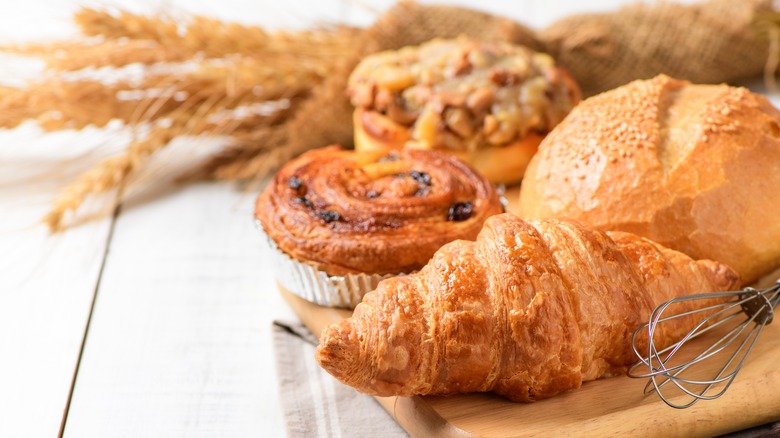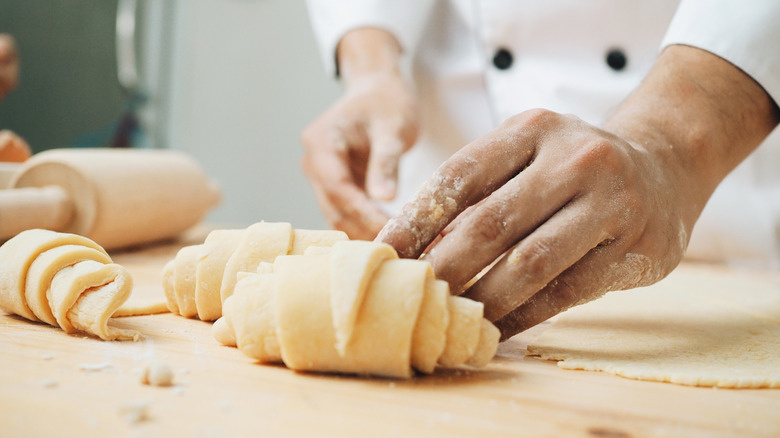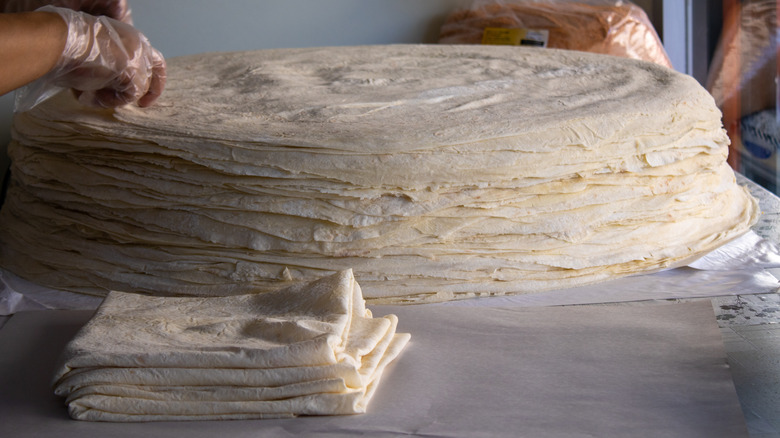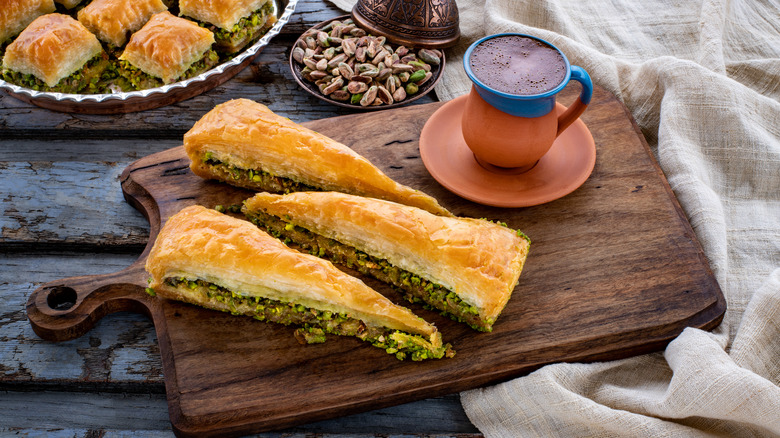What's The Difference Between A Puff Pastry And Phyllo Dough?
A good old-fashioned pastry dish is wonderful for any time of year. Whether you're looking for a warm breakfast snack or a wedding appetizer, pastries are going to stick the landing. But what exactly is a pastry? Isn't it just bread? Well, yes ... but it is a special kind of bread. Britannica defines pastry as a dough with a uniquely high amount of fat when compared with other bread doughs. Pastries also tend to be dry, buttery, and flaky, with layers of fat used to steam the dough while baking. Macmillan Dictionary dates the history of the pastry back to the Ancient Egyptians, who mixed flour and water and wrapped the dough around meat to bake.
Pastry has evolved into a careful art since then and often takes hours or days to make at home. A delicate, time-honored process, pastry making is difficult and labor intensive, but it is worth all the effort. Delicious dishes are made from pastries around the world and are notably similar in some ways and different from each other in others. The intricacies of various pastries are best looked at by observing the features of two iconic versions, puff and phyllo.
What is puff pastry?
Puff pastry, also known as pâte feuilletée, is older than you might think. Originally, the puff pastry was invented in France in the year 1645 by kitchen apprentice Claudius Gele. The Kitchen Project claims that Gele was attempting to make a new kind of bread for his ill father when he began incorporating butter into bread dough, unknowingly folding pockets of fat into the bake, which would melt and create the buttery and fluffy pastry we adore today.
Bakers now intentionally force cold butter between folds of lean dough to create dozens of layers within the pastry. The Kitchn says that by using butter to separate the dough, when the pastry bakes, the fat melts, and steam is released, which puffs the layers of bread up and turns the baked good an attractive golden color. We often see puff pastry in bakeries and coffee shops used to make fruit tarts, savory appetizers, apple turnovers, or flaky palmiers. Puff pastry, though often viewed as a dessert pastry, is also used as a base for savory dishes as well.
What is phyllo dough?
Phyllo, also spelled filo, was invented in the Byzantine empire during the 11th century and is ancient when compared to the relatively shorter history of puff pastry. The Byzantine empire stretched across Asia Minor, Greece, and even into the southern tip of Italy for centuries, so when the phyllo was invented, it spread to these different peninsulas and became ingrained into their cuisine (via Britannica).
Phyllo, according to Bakerpedia, is made of flour, water, vinegar, fat, and salt, which are mixed and stretched until they are paper thin, crispy, flat sheets. Phyllo, like puff pastry, is used in both sweet and savory dishes such as baklava, which is a nutty, sweet dessert, and spanakopita which is phyllo-wrapped spinach and cheese. Phyllo is kept frozen until it is ready to be used, and then it is thawed in the refrigerator (via Greek Boston). Because of its extremely delicate nature, if you use phyllo before it is thawed, the pastry will break apart. Additionally, it is prone to drying out, so make sure to prepare all the other aspects of your meal before pulling out the phyllo to keep it from drying.
Can you use them interchangeably?
While puff pastry and phyllo are both considered pastries, their physical difference makes these breads individual from each other. Puff pastry, once baked, puffs up and visually becomes thicker, and the dough before baking is much sturdier than phyllo. Phyllo, on the other hand, literally translates to the Greek word for leaf and is incredibly thin both before and after baking. However, when phyllo is prepared in the traditional method, by layering the individual sheets on top of each other with butter in between and then baked until golden and flaky (via The Chopping Block), the ancient pastry begins to emulate the nature of puff pastry. Because puff pastry and butter layered phyllo reflect each other in flavor and flaky texture, they can sometimes be used interchangeably if you're willing for your baked goods to come out a bit different than you're used to.
If you have to replace phyllo with puff pastry or vice versa, Taste Of Home warns that you will experience different results if your recipe calls for one and you choose to use the other. For example, if you are out of phyllo and use puff pastry for your baklava, the texture will feel very different, and your yiayia (aka grandma) will roll over in her grave, but otherwise, it is doable in a pinch. But, honestly, it's better to be safe than sorry. Martha Stewart advises against using these pastries interchangeably if you are expecting an authentic culinary experience.



